‘Word Suite’ Combines Poetry and Music
Phoebe Carrai says that her cello, which is named Giovanni, has a voice of its own and when she plays, “it feels like a true partner.” The instrument, made by Italian luthier Carlo Annibale Tononi around 1705, was the inspiration for “Word Suite,” a collaborative performance by Carrai and poet Mary Maxwell, at Cotuit Center for the Arts (4404 Falmouth Road) on Sunday, Sept. 10 at 4 p.m.
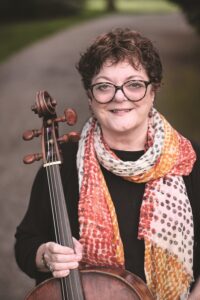
Carrai acquired the cello in Germany in the mid-1980s and says that she had it “completely taken apart and put into Baroque condition.” Restoring the instrument took two years, a process that “freed its voice.”
Carrai will play movements from each of J.S. Bach’s six cello suites, including the allemande from the sixth, which was originally composed for an instrument with five strings. Carrai has transposed the music down a fifth for her four-stringed instrument to evoke a comparable resonance. The cello suites are heavily ornamented in a style common in Baroque music. Musical decorations like trills, improvisatory runs, and virtuosic flourishes offer soloists a kind of freedom. Carrai, who teaches historical performance at the Juilliard School, tells her cello students to perform the suites “as if they were writing it in the moment.”
Maxwell will read her poems — which are verbal responses to the cello suites — between each of the movements. She says she visualizes the project as six different buildings, corresponding to the six different suites, and that Carrai will occupy one room, represented by one movement, in each. “My job is to create a corridor between these rooms,” says Maxwell. “I’ll give, through words, a connecting passage from the first to the sixth, the sixth to the third, and so on.” Like Carrai’s music, Maxwell’s poems in “Word Suite” are also ornamented: in addition to a verbal “core melody,” the poems include italicized ornamentations in their written form.
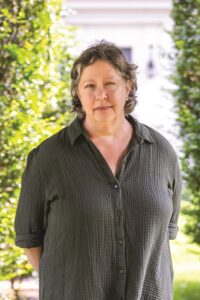
Every movement in each of the suites is a dance, except for the preludes, and Giovanni the cello is well suited for those dances. “It has a distinct personality,” says Maxwell. “It’s an extraordinary sound.” The cello is “athletic,” she continues: “When Phoebe is playing, it does feel like she’s dancing with the cello.” In the end, Maxwell will have led listeners back to the first suite for the final gigue, a nimble and uniquely joyful dance.
Tickets are sold as part of a “pick your price” program, starting at $10. See artsonthecape.org for information. —Dorothea Samaha
Barbara Gordon’s Art of the Lost and Found
At first, Barbara Gordon’s spare, colorful, and formally inventive oil-on-paper studies, in which traffic cones and empty roads figure prominently, seem devoid of human presence. But there’s a personal story behind them.
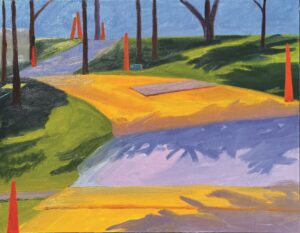
“[The series] combine[s] my responses to certain kinds of landscapes with the story about how I am experiencing living with my husband’s dementia,” says Gordon in a statement accompanying her exhibition “Tales of the Farblunget” at the Wellfleet Adult Community Center (715 Old Kings Hwy.) “Farblunget means ‘lost and confused’ in Yiddish. My husband has Alzheimer’s disease. The ‘conversations’ that my lost and confused husband and I have these days are not only excruciatingly repetitive, but they are also often absurd, strange, surreal, and sometimes, especially in retrospect, hilarious.”
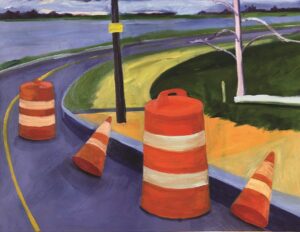
The street scenes and landscapes, with their skewed perspectives, mysterious shadows, and rhythmic compositions, become visual metaphors for both Gordon’s husband’s condition and her own ways of navigating their shared experience. The titles of the works in the series range from the comical (Gum can ruin a forty-dollar sport coat) to the surreal (Do you do much birdwatching at your place?) to the poignant (I don’t live here) and acquire an additional layer of meaning when Gordon explains where they come from.
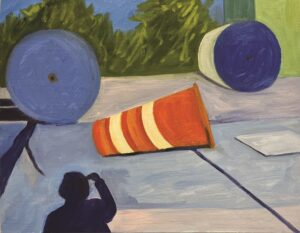
“The titles of these paintings are direct quotes from him,” says Gordon. “This is my way of processing, communicating, and making a record of my experience. No one could imagine what it’s like unless you could witness it.”
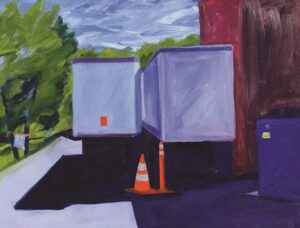
The exhibition is on view at the center from 8 a.m. to 4 p.m. daily through Sept. 29. Gordon will discuss her work at an opening reception on Sunday, Sept. 10 at 1 p.m., and the talk will be followed at 2 p.m. by a question-and-answer session with staff members from the Alzheimer’s Family Support Center of Cape Cod. See wellfleetcoa.org for more information. —John D’Addario
Watching Out for Beth Malone
Beth Malone rose to prominence when she portrayed the adult version of beloved graphic novelist Alison Bechdel (Dykes to Watch Out For) in the 2015 Broadway musical hit Fun Home. A story about a young woman’s journey to self-acceptance and her closeted father’s descent into suicide, both the graphic novel and the musical are considered groundbreaking works of art for their layered and honest depictions of the LGBTQ struggle. Malone comes to Provincetown for two performances at the Art House on Friday, Sept. 8 and Saturday, Sept. 9 at 7 p.m. She will be accompanied by host (and stellar showman himself) Seth Rudetsky.
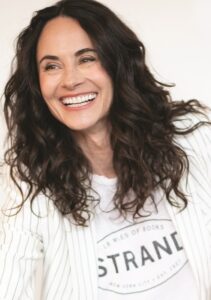
In addition to having been nominated for a Tony Award for her performance in Fun Home, Malone is a skilled cabaret performer who regularly appears at New York City’s 54 Below, a premier venue for Broadway singers. She also recently wrapped up an off-Broadway (many are hoping pre-Broadway) run as the titular character in The Unsinkable Molly Brown, directed by Broadway powerhouse Kathleen Marshall.
It’s difficult to conceive of two characters more different than the introverted Alison of Fun Home and the ebullient Molly Brown. But Malone’s chameleon-like soprano glides easily across roles and through many different styles and genres of music. In a video interview with Broadway World, Malone, who is gay, said that when she has the chance to play “girly-girls” she channels drag queens: “I’ve been damn lucky to be born genetically sort of petite and able to put on eyelashes and some lipstick and just transform into a drag queen.” —James Judd
Celebration of Life Concert Returns
After a three-year pandemic-driven hiatus, the 27th annual Celebration of Life concert returns to the Unitarian Universalist Meeting House in Provincetown (236 Commercial St.) on Friday, Sept. 8 at 8 p.m.
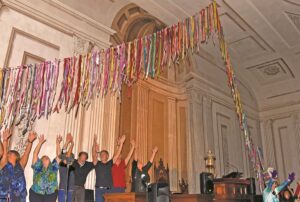
The concert, which is billed as Provincetown’s longest-running free music festival, has been held annually on the Friday after Labor Day since 1994. It has also become a companion event to the annual Provincetown Swim for Life & Paddler Flotilla, which begins on Saturday, Sept. 9 at 8 a.m. simultaneously in Provincetown Harbor and at Great Pond in Wellfleet.
This year’s program features performances by a lineup of mostly Outer Cape-based artists including Megan Amorese, Arian Carlos, Chanthoeun Varon Collins, Donnelly & Richardson, Harrison Fish, Deyan Gerginov, Sue Goldberg, Billy Hough, Zack Johnson, Zoë Lewis, Ken Lonergan, Madison Mayer, DeAngelo Nieves, John Thomas, Peter Toto, Darlene Van Alstyne, Janet Villas, and the Rev. Kate Wilkinson.
As in previous years, the concert will be preceded by drumming in the meeting house sanctuary as audience members enter the space. At precisely 8 p.m., hundreds of colorful prayer ribbons are raised to the top of the ceiling to mark the official start of the celebration.
The celebration is produced and hosted by John Thomas, who conceived the annual “fun-raiser” in the early 1990s after being inspired by the International AIDS Candlelight Vigil that took place in Provincetown on the Sunday before Memorial Day weekend every year. “I wanted to create something that could balance the sorrow with joy, something that celebrated those who had passed and the precious gift of life that all of us have,” said Thomas in a statement accompanying the announcement of this year’s celebration.
Thomas emphasizes that the celebration is free. “We do not charge any admission fee or accept any donations,” he says. “Almost everything is done without money. It’s all the energy of giving and receiving and sharing our time, talent, enthusiasm, and presence together. Creating goodwill and fun is the ultimate purpose.” See uumh.org for more information.
Resident Artists Are ‘Still Doing It’ at Seashore Point
A ceramic reproduction of an iconic red dory; a vivid self-portrait of a man in the mid-1980s; a wool Aran cardigan darned earlier this year: all are among the 65 works on display at Seashore Point (100 Alden St., Provincetown) this month in the Seashore Point Art Committee’s new group show. Titled “Still Doing It…,” the show is said to be one of the community’s most ambitious to date.
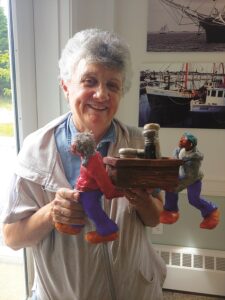
“There’s a lot of talent in the building,” says Richard Lacasse. A former employee of PAAM and an artist in his own right, Lacasse is the curator of the exhibition, which features work only by artists who live at Seashore Point. The 14 living artists represented — Gail Bliss, Joan Boudreau, Will Buckley, Larry R. Collins, Patricia van Dijkhuizen, Dale Feid, Richard Kapler a.k.a. Wave, Lorraine Kujawa, Richard Lacasse, Jackie Lipton, Diana Liu, Connie Tavanis, Tim Wahl, and Mallory White — are all either full-time or part-time residents. There is also one piece by the late Raynor (Ollie) Ahmuty.
Lacasse says there’s no specific theme to the show and notes that many classic Provincetown art styles and techniques are on view, including white-line woodblock prints, abstract expressionist paintings, and pieces using found materials — not to mention landscape paintings and photographs of the town itself.
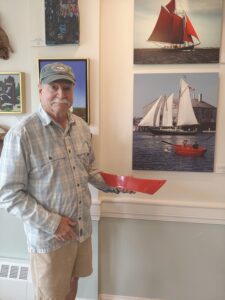
“It’s nice because we don’t have to sell, we don’t have to show,” says Connie Tavanis, an artist with seven pieces in the show that range from whimsical sculptures to more serious paintings touching on trauma from her youth. Tavanis savors the fact that most of the artists on display are unrepresented by galleries and therefore free of the commercial demands of the art world.
At the same time, Dale Feid, another artist and chair of the Art Committee, hopes that low commission fees — along with a fresh coat of paint in the bright and airy Hatches Harbor Room where the exhibition takes place — will help raise the space’s status in town and lead to more bookings by local groups. The committee is also exploring the possibility of converting several unused rooms in the complex into studios so that even more residents can have the opportunity to create.
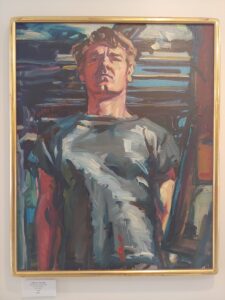
Roughly half of the works in the show are on sale and may be purchased from the artists directly or through the Seashore Point front desk. The exhibition runs through Sept. 15. —Derek McCormack
Twins on Strings at the Post Office Café
When identical twin brothers Stephen and Jeff Neil were growing up in Vienna, Va., they discovered an old violin in their parents’ closet that had been made by their great-grandfather, a blacksmith, during the Great Depression. “After a year of pestering” their parents, says Stephen, they started learning to play violin at nine years old.

Now, years later, they have left their traditional instruments behind. Jeff plays a seven-string Viper electric violin, which looks a lot like an electric guitar. Stephen plays a four-string Aurora electric violin. Since 2013, the pair has traveled the world as the Synergy Twins, playing what Stephen says is everything from “Celtic to country to EDM to top 40 to power ballads to Broadway musicals.” His own preference is “classical crossovers”: “Like ‘Summer’ from Vivaldi’s Four Seasons,” he says. “We made a rendition that has a modern twist with a dance backbeat behind it. Vivaldi might be rolling over in his grave when he hears it.” Jeff prefers using different effects pedals and “taking a Led Zeppelin song, putting a distortion on his violin, and having fun with that.” Though their preferences diverge, they always manage to have a cohesive program.
“Being identical twins is a rarity on its own,” Stephen says. “Being gay electric-violin twins is even more niche.” This rarity has brought them success. They’ve played on cruise lines, at Pride festivals, at sports events, and for celebrities. They’ll make their Provincetown debut at the Post Office Café and Cabaret on Friday, Sept. 8 at 7:30 p.m.
As for the program, Stephen says, “It’s a mystery even to us.” While they’ll probably play some of their “tried and true” numbers — a mix of Celtic tunes, classical crossovers, and pop covers — the program will change based on the audience’s reception. “We try to play something for everyone,” Stephen says. “It turns out well 99 percent of the time.”
Tickets are $35 ($40 for V.I.P. seating). See postofficecafe.net for information. —Eve Samaha



